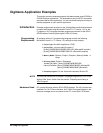
46 Digitizers Command Reference Chapter 3
CALCulate is the root command, LIMit is a second level command, FAIL?,
LOWer and UPPer are third level commands and DATA, DATA?, STATe
and STATe? are fourth level commands.
Command Separator A colon (:) always separates one command from the next lower level
command, such as CALCulate:LIMit:FAIL? Colons separate the root
command from the second level command (CALCulate:LIMit) and the
second level from the third level (LIMit:FAIL?).
Abbreviated Commands The command syntax shows most commands as a mixture of upper and
lower case letters. The upper case letters indicate the abbreviated spelling
for the command. For shorter program lines, send the abbreviated form.
For better program readability, you may send the entire command. The
instrument will accept either the abbreviated form or the entire command.
For example, if the command syntax shows CALCulate, then CALC and
CALCULATE are both acceptable forms. Other forms of CALCulate, such as
CALCU or CALCUL will generate an error. Additionally, SCPI commands
are case insensitive. Therefore, you may use upper or lower case letters and
commands of the form CALCULATE, calculate, and CaLcUlAtE are all
acceptable.
Implied Commands Implied commands are those which appear in square brackets ([]) in the
command syntax. (Note that the brackets are not part of the command; do
not send them to the instrument.) Suppose you send a second level
command but do not send the preceding implied command. In this case, the
instrument assumes you intend to use the implied command and it responds
as if you had sent it. Examine the partial SENSe subsystem shown below:
[SENSe:]
VOLTage[:DC]:RANGe <range>|MIN|MAX
VOLTage[:DC]:RANGe? [MIN|MAX]
The root command SENSe is an implied command and so is the third level
command DC. For example, to set the digitizer's DC voltage range to MAX,
you can send one of the following three command statements:
SENS:VOLT:DC:RANG MAX
VOLT:DC:RANG MAX
VOLT:RANG MAX
Parameters ParameterTypes. The following table contains explanations and examples of
parameter types you might see later in this chapter.
Type Explanations and Examples
Boolean Represents a single binary condition that is either true or
false. (ON, OFF, 1.0). Any non-zero value is considered
true.


















